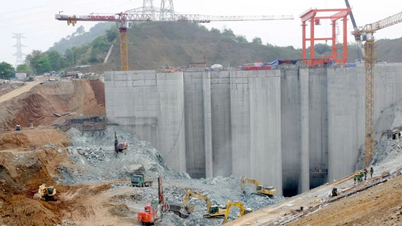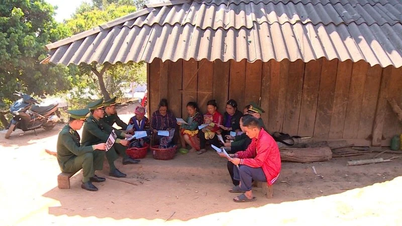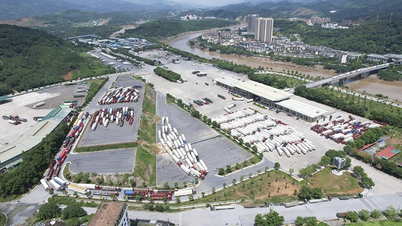According to the forecast of the National Hydrometeorological Agency, the North is immersed in the strongest cold air mass since the beginning of the season, many places have frost and ice with temperatures in low mountainous areas below 5 degrees Celsius, the feeling of cold is increasing.
In the middle of this week, the North will be affected by a cold front, causing severe cold, with sunny days and the possibility of frost lasting for another 1-2 days.
The North is experiencing the strongest cold spell since the beginning of the season.
According to the National Center for Hydro-Meteorological Forecasting, the North is experiencing the strongest cold spell since the beginning of the season when at 6am on January 13, the actual temperature measured in 20 northern provinces and cities was below 10 degrees Celsius, of which Lang Son had the lowest at 2.5 degrees Celsius, the weather continues to be very cold today.
Among the 20 provinces and cities above, Lang Son and Cao Bang are the two localities with the lowest actual temperatures this morning, at 2.5 and 3.2 degrees Celsius respectively. In Bac Kan, Son La, and Tam Duong (Lai Chau), the temperature at 6am also fluctuated between 4.8 and 5.8 degrees Celsius. The temperature at 6am in Ha Dong ( Hanoi ) was recorded at 7.3 degrees Celsius.

Trees are frozen white on top of Fansipan ( Lao Cai ). Photo: Lao Cai Newspaper.
According to the National Center for Hydro-Meteorological Forecasting, due to the influence of the continental cold high pressure combined with the high-altitude wind divergence, the weather in the northern provinces is generally rainless, sunny during the day, foggy in some places in the early morning, light wind, cold at night, severe cold in the highlands. Many places have dropped to 0 degrees Celsius, with frost appearing.
On high mountain points such as Pha Din, Tam Dao, Mau Son, Sa Pa, the temperature is only 3 - 7 degrees Celsius. At Phia Oac peak in Cao Bang, yesterday morning, January 12, frost and frost were recorded when the temperature dropped to around 0 degrees Celsius. Frost covered all signs, roads, and trees.
In Lao Cai, frost appeared on some high mountain peaks such as Lao Than, Ky Quan San and some points in Y Ty commune, Bat Sat district.

The temperature in Y Ty commune, Bat Xat district, Lao Cai province dropped sharply, ice and snow appeared covering the trees... Photo: Xuan Cho.
The meteorological agency forecasts that on the night of January 13, the lowest temperature will tend to increase gradually, commonly 10-13 degrees in the plains and midlands; 10-12 degrees in Hanoi; 8-10 degrees in mountainous areas, and below 5 degrees in high mountainous areas. The highest temperature on January 14 will commonly be 21-23 degrees.
From the night of January 14-16, the lowest temperature in the Northern region is generally 13-16 degrees, especially in mountainous areas 10-13 degrees, in high mountainous areas below 7 degrees; the highest temperature is generally 20-22 degrees. It is forecasted that in the next few days, the North will continue to have sunny weather, the highest temperature during the day is from 22-24 degrees, the temperature at night will gradually increase by 2-3 degrees each day.
The meteorological agency said that from now until February 10, cold air will tend to be more active, concentrated in the first half of the forecast period, and there is a possibility of many days of severe cold.
The average temperature nationwide during this period is approximately the average of many years, in which the North is 0.5-1 degree Celsius higher.
Also during this period, the South Central region may experience some scattered showers and thunderstorms, locally heavy rain; the South may experience some unseasonal rainy days. The total rainfall in the North and Central regions is generally 10-20mm lower, the Central Highlands and the South are approximately the average of many years during the same period.
Cold air can cause many days of severe cold in the Northern provinces, with the risk of frost and frost, which can greatly affect livestock, crops and people's health, especially in the northern mountainous areas. The Southern region will also experience heavy rain, strong thunderstorms with whirlwinds, lightning, hail and gusts of wind, which can greatly affect production and people's activities.
In addition, from now until February 10, storms and tropical depressions are unlikely to appear in the East Sea or affect Vietnam's mainland, mainly due to the activity of the southern equatorial trough.
In late January and early February 2025, there will be many cold spells, severe cold with frost, high possibility of frost.
According to the National Center for Hydro-Meteorological Forecasting, in January, the average temperature nationwide was approximately the same as the average of many years in the same period.
Total rainfall in the North and provinces from Thanh Hoa to Da Nang during this period is generally 10-20mm lower than the average of many years; other areas are generally 5-10mm higher than the average of many years in the same period.
Notably, in early January, the low pressure trough with an axis of about 6-9 degrees north latitude connecting with a low pressure area in the southern East Sea will cause strong winds, large waves and thunderstorms in many sea areas; after that, the low pressure trough tends to lower its axis to the south and gradually fades away.
In particular, according to meteorological experts, in January, cold air tends to be more active than in December 2024; there is a high possibility of causing many days of severe cold in the northern provinces, likely concentrated in mid-January.
In addition, during the forecast period, the South Central region is likely to experience some scattered showers and thunderstorms, with some localized moderate and heavy rains; the Southern region may experience some unseasonal rainy days. During thunderstorms, it is necessary to be on guard against the possibility of extreme weather phenomena such as tornadoes, lightning, hail and strong gusts of wind.

Latest cold air news: January and February 2025 will see many cold spells, severe cold with frost, high possibility of frost.
Warning, cold air and dangerous weather phenomena at sea are likely to cause strong winds and large waves affecting ship operations.
On land, cold air can cause many days of severe cold in the northern provinces, with the risk of frost and ice causing great impacts on livestock, crops and people's health, especially in the northern mountainous areas.
In addition, heavy rain, thunderstorms accompanied by whirlwinds, lightning, hail and gusts of wind can greatly affect production and people's activities.
According to the National Center for Hydro-Meteorological Forecasting, in the first 3 months of 2025, ENSO will continue to remain neutral. It is forecasted that the average temperature across the country from January to March 2025 will generally be approximately the same as the average of many years during the same period.
In addition, in the first 3 months of 2025, there is a low possibility of storms/tropical depressions operating in the East Sea and affecting our country (at a level approximately equal to the average of many years: 0.6 storms in the East Sea, 0.1 storms making landfall).
In particular, according to experts, cold air is likely to be active in January and February 2025, causing severe cold spells; in March 2025, cold air activity will be approximately the average of many years. It is necessary to be on guard against the possibility of severe cold spells accompanied by frost and ice during this time, especially in the northern mountainous areas.
In the Southern region, from January to March 2025, heat waves are likely to appear approximately at the average of many years (concentrated in the Southeast region).
Regarding the rainfall situation nationwide, in January and February 2025, the total rainfall in the Northern region is generally from 20-40mm (approximately compared to the average of many years in the same period). In March 2025, the total rainfall is generally 50-80mm (5-10mm larger than the average of many years in the same period).
In the Central region, in January 2025, total rainfall in the North Central region is generally from 20-50mm, in Ha Tinh in some places it is over 100mm (at a threshold approximately compared to the average of many years); in the Central and South Central regions it is generally 50-160mm (at a threshold approximately compared to the average of many years).
In February 2025, total rainfall in the North Central region is generally 20-50mm, with Ha Tinh having some places over 100mm (approximately the average of many years); in the Central and South Central regions, total rainfall is generally 30-60mm, with some places being higher (5-15mm higher than the average of many years), with Ninh Thuan-Binh Thuan provinces having little rain with total rainfall generally 5-15mm.
In March 2025, the total rainfall in the Central region is approximately the same as the average of many years, specifically: the North Central region is generally 30-60mm; the Central and South Central regions have a total rainfall of 40-70mm, some places are higher (15-30mm higher than the average of many years); Ninh Thuan-Binh Thuan provinces have little rain with total rainfall generally below 10mm.
In the Central Highlands and the South, from January to March 2025, total rainfall in the Central Highlands and the South is generally higher than the average of many years in the same period (5-15mm higher than the average of many years).
Meteorological experts warn that during the forecast period (January-March 2035), dangerous weather phenomena such as thunderstorms, tornadoes, lightning and strong gusts of wind will continue to occur nationwide.
Thunderstorms, tornadoes, lightning, hail, severe cold, frost, and ice can negatively affect agricultural production activities and public health in areas across the country.
In addition, the northeast monsoon is likely to cause strong winds and large waves affecting activities at sea.
Source: https://danviet.vn/tin-khong-khi-lanh-moi-nhat-dang-ret-dam-giua-tuan-nay-mien-bac-lai-don-khong-khi-lanh-tang-cuong-20250109141114431.htm



![[Photo] Prime Minister Pham Minh Chinh receives the President of Asia-Pacific region of PowerChina Group](https://vphoto.vietnam.vn/thumb/1200x675/vietnam/resource/IMAGE/2025/5/21/0f4f3c2f997b4fdaa44b60aaac103d91)
![[Photo] Scientific workshop "Building a socialist model associated with socialist people in Hai Phong city in the period of 2025-2030 and the following years"](https://vphoto.vietnam.vn/thumb/1200x675/vietnam/resource/IMAGE/2025/5/21/5098e06c813243b1bf5670f9dc20ad0a)
![[Photo] Coming to Son La, let's "show off" with the Wallflowers](https://vphoto.vietnam.vn/thumb/1200x675/vietnam/resource/IMAGE/2025/5/21/627a654c41fc4e1a95f3e1c353d0426d)
![[Photo] Prime Minister Pham Minh Chinh receives Rabbi Yoav Ben Tzur, Israeli Minister of Labor](https://vphoto.vietnam.vn/thumb/1200x675/vietnam/resource/IMAGE/2025/5/21/511bf6664512413ca5a275cbf3fb2f65)

























































































Comment (0)